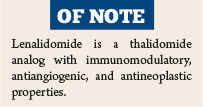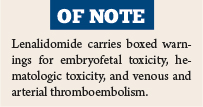In the Clinic provides overviews of novel oncology agents, addressing indications, mechanisms, administration recommendations, safety profiles, and other essential information needed for the appropriate clinical use of these drugs.
On February 22, lenalidomide (Revlimid) was approved as maintenance therapy for patients with multiple myeloma following autologous hematopoietic stem cell transplantation.1,2 The drug was previously approved to treat multiple myeloma (in combination with dexamethasone), anemia caused by del(5q)-related myelodysplastic syndromes, and relapsed mantle cell lymphoma.
Supporting Efficacy Data
The current approval was based on findings in the Cancer and Leukemia Group B (CALGB) 100104 and Intergroupe Francophone du Myelome (IFM) 2005-02 randomized trials of lenalidomide maintenance vs placebo after autologous stem cell transplant.2

In CALGB 100104, patients aged between 18 and 70 years who had undergone induction therapy followed by autologous stem cell transplant were eligible. Induction therapy must have occurred within 12 months. Within 90 to 100 days after stem cell transplant, patients with at least a stable disease response were randomized to receive either lenalidomide or placebo.
In IFM 2005-02, patients aged < 65 years who had undergone induction therapy followed by stem cell transplant and had achieved at least a stable disease response at the time of hematologic recovery were eligible. Within 6 months after stem cell transplant, patients were randomized to receive either lenalidomide or placebo.
Patients in both trials had to have creatinine clearance ≥ 30 mL/min. In both trials, the lenalidomide dose was 10 mg once daily on days 1 to 28 of repeated 28-day cycles and could be increased to 15 mg once daily after 3 months in the absence of dose-limiting toxicity; treatment was to be continued until disease progression or patient withdrawal.
In CALGB 100104, among 231 patients randomized to receive lenalidomide vs 229 randomized to receive placebo, median progression-free survival was 33.9 vs 19.0 months (hazard ratio [HR] = 0.38, P < .001) at unblinding and 68.6 vs 22.5 months (HR = 0.38, 95% confidence interval [CI] = 0.28–0.50) at updated analysis in March 2015. In IFM 2005-02, among 307 lenalidomide patients vs 307 placebo patients, median progression-free survival was 41.2 vs 23.0 months (HR = 0.50, P < .001) at unblinding and 46.3 vs 23.8 months (HR = 0.53, 95% CI = 0.44–0.64) at updated analysis. At updated overall survival analysis in February 2016, median overall survival was 111.0 vs 84.2 months (HR = 0.59, 95% CI = 0.44–0.78) in CALGB 100104 and 105.9 vs 88.1 months (HR = 0.90, 95% CI = 0.72–1.13) in IFM 2005-02.
How It Works
Lenalidomide is a thalidomide (Thalomid) analog with immunomodulatory, antiangiogenic, and antineoplastic properties. It inhibits proliferation and induces apoptosis of certain hematopoietic tumor cells, including mantle cell lymphoma, multiple myeloma, and del(5q) myelodysplastic syndrome in vitro and delays tumor growth in hematopoietic tumor models including multiple myeloma.
New Indication for Lenalidomide
- Lenalidomide (Revlimid) was approved as maintenance therapy for patients with multiple myeloma following autologous hematopoietic stem cell transplantation.
- The recommended starting dose in this setting is 10 mg once daily continuously (days 1–28 of repeated 28-day cycles) until disease progression or unacceptable toxicity; after 3 cycles of maintenance therapy, the dose can be increased to 15 mg once daily.
Immunomodulatory properties of the agent include activation of T cells and natural killer cells, increased numbers of natural killer T cells, and inhibition of proinflammatory cytokines (eg, tumor necrosis factor-α and interleukin-6) by monocytes. The combination of lenalidomide and dexamethasone synergizes the inhibition of cell proliferation and the induction of apoptosis in multiple myeloma cells.
How It Is Used
After autologous stem cell transplant, lenalidomide maintenance can be started after adequate hematologic recovery (absolute neutrophil count ≥ 1,000/µL and/or platelet count ≥ 75,000/µL). The recommended starting dose is 10 mg once daily continuously (days 1–28 of repeated 28-day cycles) until disease progression or unacceptable toxicity.

After 3 cycles of maintenance therapy, the dose can be increased to 15 mg once daily if tolerated. In patients with renal impairment, starting doses are 5 mg once daily for creatinine clearance of 30 to 60 mL/min, 2.5 mg once daily for < 30 mL/min not requiring dialysis, and 2.5 mg once daily for < 30 mL/min requiring dialysis with the dose given following dialysis on dialysis days.
Treatment should be interrupted in patients developing grade 3 or 4 thrombocytopenia (platelet count < 30,000/µL) or neutropenia (absolute neutrophil count < 500/µL) and complete blood cell counts should be followed weekly; upon recovery, treatment should be resumed at a lower dose. Similarly, treatment should be interrupted for other grade 3 or 4 adverse events and resumed at a lower dose upon resolution to grade ≤ 2.
Periodic monitoring of digoxin plasma levels is recommended in patients receiving concomitant treatment due to increased digoxin exposure with concomitant lenalidomide. Patients taking concomitant therapies such as erythropoietin-stimulating agents or estrogen-containing therapies should be monitored for increased risk of thrombosis.
Safety Profile
Adverse events were reported from both the posttransplantation (completion of high-dose melphalan/autologous stem cell transplant) and maintenance periods for CALGB 100104 and from the maintenance treatment period only for IFM 2005-02. Onset of adverse events was generally highest in the first 6 months of treatment, with frequency decreasing or remaining stable over time throughout treatment.
The most common adverse events of any grade across both maintenance studies (> 20% of lenalidomide patients) were neutropenia, thrombocytopenia, leukopenia, anemia, upper respiratory tract infection, bronchitis, nasopharyngitis, cough, gastroenteritis, diarrhea, rash, fatigue, asthenia, muscle spasm, and pyrexia. The most common grade 3 or 4 adverse events in the two studies (vs placebo) included neutropenia (59% vs 33% and 54% vs 8%), thrombocytopenia (38% vs 30% and 13% vs 3%), and leukopenia (20% vs 10% and 24% vs 2%). Serious adverse events occurring in > 4.5% of lenalidomide patients were lung infection and neutropenia. The most common adverse events leading to discontinuation of lenalidomide were thrombocytopenia (2.7%) and neutropenia (2.4%).
In patients receiving lenalidomide maintenance therapy following high-dose intravenous melphalan and autologous stem cell transplant, hematologic second primary malignancies occurred in 7.5% of patients compared to 3.3% of patients receiving placebo. The incidence of hematologic plus solid tumor (excluding squamous cell carcinoma and basal cell carcinoma) malignancies was 14.9% vs 8.8%, with a median follow-up of 91.5 months. Nonmelanoma skin cancer, including squamous cell carcinoma and basal cell carcinoma, occurred as second primary malignancies in 3.9% vs 2.6%.
Lenalidomide carries boxed warnings for embryofetal toxicity, hematologic toxicity, and venous and arterial thromboembolism. To avoid embryofetal exposure, lenalidomide is available only through a restricted distribution program (Revlimid Risk Evaluation and Mitigation Strategy [REMS]). Pregnancy must be excluded before the start of treatment and should be prevented during treatment by the use of two reliable methods of contraception. Antithrombotic prophylaxis is recommended.
Lenalidomide also carries warnings/precautions for serious and fatal cardiac adverse events (observed in patients with chronic lymphocytic leukemia), second primary malignancies, hepatic failure including fatalities, allergic reactions including fatalities, tumor-lysis syndrome including fatalities, tumor flare reactions (observed in chronic lymphocytic leukemia and lymphoma), and impaired stem cell mobilization. Women should be advised not to breastfeed during treatment. ■
Report Adverse Events
Health-care professionals should report all serious adverse events suspected to be associated with the use of any medicine or device to FDA’s MedWatch Reporting System by completing a form online at www.fda.gov/medwatch/report.htm, by faxing (1-800-FDA-0178), by mailing the postage-paid address form provided online, or by telephone (1-800-FDA-1088).
References
1. U.S. Food and Drug Administration: Lenalidomide (Revlimid). Available at https://www.fda.gov/Drugs/InformationOnDrugs/ApprovedDrugs/ucm542791.htm. Accessed March 9, 2017.
2. Revlimid (lenalidomide) capsules prescribing information, Celgene Corporation, February 2017. Available at http://www.celgene.com/content/uploads/revlimid-pi.pdf. Accessed March 9, 2017.

